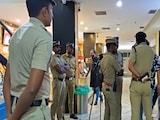- Team Galactic Gearheads from Pune Institute won ISRO's Fly Me on Mars challenge
- Their 1.7 kg drone performed autonomous take-off, hover, landing, and return functions
- The drone used optical flow algorithms and LiDAR terrain scanning without GPS support
In a remarkable display of innovation and engineering prowess, a team of students from the Pune Institute of Computer Technology (PICT) emerged victorious in the prestigious ISRO Robotic Challenge, themed 'Fly Me on Mars'. The challenge, organised by ISRO's U R Rao Satellite Centre (URSC), invited student teams across India to develop autonomous navigation systems for aerial vehicles designed to operate on the Martian surface - without relying on external aids like GPS or compass.
The winning team, Galactic Gearheads, led by students Hrushikesh Patwardhan, Nimish Satav, and Kaushal Chaudhari, and mentored by Dr Sandeep Gaikwad, built a lightweight drone weighing 1.7 kilograms, well within the 2 kg limit set by ISRO. Their drone demonstrated autonomous capabilities including vertical take-off, hover, safe landing, and return to base - all without external navigation support.
In the final round, 16 teams from across India competed to make the best Martian drone.
The challenge simulated Martian conditions, where traditional navigation systems like GPS are unavailable. The Pune team tackled this by integrating optical flow algorithms, Light Detection and Ranging (LiDAR) based terrain scanning, and they constructed a 9x12 meter Mars-like test arena at their college to validate their design.
This achievement is particularly poignant given that the first helicopter to fly on Mars - NASA's Ingenuity - was designed by an Indian engineer, Dr Bob Balaram. His pioneering work laid the foundation for aerial exploration on Mars.
The Galactic Gearheads team expressed hope that their drone would one day fly on Mars as part of India's space exploration efforts.
ISRO is already planning a follow-up mission to Mangalyaan, where a soft landing on the red planet will be attempted.
India's first Mars mission, Mangalyaan, launched in 2013, was a resounding success, placing India among the elite group of nations with interplanetary capabilities. With follow-up missions, including potential Mars landing missions, being planned by ISRO, the technologies demonstrated that the students could play a vital role. If validated and refined, student-developed systems like the one from PICT could be integrated into future ISRO missions, offering indigenous solutions for autonomous aerial exploration on Mars.
The ISRO challenge not only showcased the talent and creativity of India's youth but also reinforced ISRO's commitment to engaging the student community in solving real-world space engineering problems. As India looks toward the red planet, the seeds of innovation are already being sown in its classrooms and labs.















